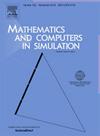有效的粒子生成深度平均和完全3D MPM使用TIFF图像数据
IF 4.4
2区 数学
Q1 COMPUTER SCIENCE, INTERDISCIPLINARY APPLICATIONS
引用次数: 0
摘要
在这项工作中,我们提出了一个全面的框架,用于在全三维(3D)和深度平均材料点法(DAMPM)模拟中生成和有效管理粒子。我们的方法利用TIFF图像数据来构建大规模地球物理流动的初始条件,主要集中在滑坡建模上。我们描述了为粒子初始化、分布和跟踪而开发的算法,以确保不同MPM配方的一致性和计算效率。所提出的方法能够准确地表示复杂的地形,同时保持数值稳定性和对不同材料行为的适应性。虽然主要应用于滑坡模拟,但概述的方法广泛适用于其他领域,包括颗粒流动,流体-结构相互作用和大变形过程。性能评估证明了我们的方法的有效性和稳健性,突出了其在地质力学及其他领域推进高保真模拟的潜力。本文章由计算机程序翻译,如有差异,请以英文原文为准。
Efficient particle generation for depth-averaged and fully 3D MPM using TIFF image data
In this work, we present a comprehensive framework for the generation and efficient management of particles in both fully three-dimensional (3D) and depth-averaged Material Point Method (DAMPM) simulations. Our approach leverages TIFF image data to construct initial conditions for large-scale geophysical flows, with a primary focus on landslide modeling. We describe the algorithms developed for particle initialization, distribution, and tracking, ensuring consistency and computational efficiency across different MPM formulations. The proposed methods enable accurate representation of complex topographies while maintaining numerical stability and adaptability to diverse material behaviors. Although the primary application is landslide simulation, the methodologies outlined are broadly applicable to other fields involving granular flows, fluid–structure interactions, and large-deformation processes. Performance evaluations demonstrate the efficiency and robustness of our approach, highlighting its potential for advancing high-fidelity simulations in geomechanics and beyond.
求助全文
通过发布文献求助,成功后即可免费获取论文全文。
去求助
来源期刊

Mathematics and Computers in Simulation
数学-计算机:跨学科应用
CiteScore
8.90
自引率
4.30%
发文量
335
审稿时长
54 days
期刊介绍:
The aim of the journal is to provide an international forum for the dissemination of up-to-date information in the fields of the mathematics and computers, in particular (but not exclusively) as they apply to the dynamics of systems, their simulation and scientific computation in general. Published material ranges from short, concise research papers to more general tutorial articles.
Mathematics and Computers in Simulation, published monthly, is the official organ of IMACS, the International Association for Mathematics and Computers in Simulation (Formerly AICA). This Association, founded in 1955 and legally incorporated in 1956 is a member of FIACC (the Five International Associations Coordinating Committee), together with IFIP, IFAV, IFORS and IMEKO.
Topics covered by the journal include mathematical tools in:
•The foundations of systems modelling
•Numerical analysis and the development of algorithms for simulation
They also include considerations about computer hardware for simulation and about special software and compilers.
The journal also publishes articles concerned with specific applications of modelling and simulation in science and engineering, with relevant applied mathematics, the general philosophy of systems simulation, and their impact on disciplinary and interdisciplinary research.
The journal includes a Book Review section -- and a "News on IMACS" section that contains a Calendar of future Conferences/Events and other information about the Association.
 求助内容:
求助内容: 应助结果提醒方式:
应助结果提醒方式:


